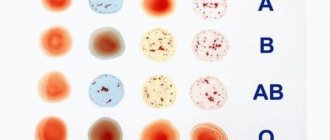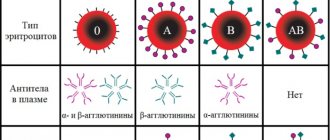What does Rh factor mean?
Blood is made up of plasma and cells, with the cells being made up of red blood cells or red blood cells whose function is to carry oxygen from the lungs to the tissues. Red cells contain 50 types of proteins, one of which is Rh factor, also known as Rh protein.
Thus, Rh factor (hereinafter referred to as R/F) is a protein located on the cell membrane of red blood cells, which has antigenic properties .
Important! Rhesus is inherited and does not change throughout life.
In addition, protein depends on where the patient lives. Thus, 15% of Europeans and 7% of black inhabitants of the Earth do not have the Rh factor. Moreover, 99% of Asians and 85% of Europeans have positive Rh.
In ordinary life, R/F will be needed during blood transfusion, as well as during pregnancy, when there is a risk of developing Rh conflict - the positive Rh factor of the fetus gets into the blood of the mother, who has negative R/F.
Also, the R/F value is necessary for: donation; preoperative period; significant blood loss.
When does Rh conflict occur?
When planning a family, you need to pay attention to a few simple points. First of all, future parents must undergo a Rh test. If it is positive or negative in both cases, there is no reason to worry. A conflict can only arise if antigen D is not detected in the mother’s blood, but the father has it.
In this case, the mother’s immune response is inevitable. Even during a normal pregnancy, the fetal Rh factor overcomes the placental barrier. In response, antibodies are formed in the mother's blood. They penetrate the placenta into the fetus, destroying its red blood cells. Over time, anemia occurs.
Bilirubin is formed in the baby's blood, which leads to the development of jaundice. It is this substance that gives a child’s skin a yellow tint. The result of Rh conflict can also be damage to the nervous system, edema and even fetal death.
Mixing of the blood of the mother and the unborn child can also occur in case of unforeseen situations. This could be an ectopic pregnancy, vaginal bleeding, or mechanical trauma to the abdomen.
Types of Rh factor
A protein built into red blood cells denotes positive Rh factor – Rh(+). In the absence of this protein, the doctor notes a negative R/F - Rh(-). According to statistics, 80% of citizens have Rh(+), and the rest have Rh(–).
Important! The terminology negative or positive Rh factor refers to the D antigen, which is present in 85% of patients.
Parents who are Rh positive have children with any Rh factor. It is important to take into account Rh when transfusing blood, since incorrect Rh setting leads to the death of the patient.
script async src="//pagead2.googlesyndication.com/pagead/js/adsbygoogle.js">
Important! Complete information on Rh positive can be found at this link.
If Rh is negative , the patient does not develop diseases and does not weaken the immune system. Negative Rh is a feature of the body that doctors take into account during pregnancy and before surgery. Thus, Rh(–) is less common in donor blood supplies than Rh positive. As a percentage, minus is 5%, and plus is 95%.
When carrying a fetus in 1 out of 10 families, Rhesus occurs - a conflict that provokes the development of problems with hearing, speech, and the child may also develop brain pathologies.
Rh compatibility
Let's find out what it is. The Rh blood of the parents is of particular importance. There is an opinion that it affects the possibility of conception, the course of pregnancy and the health of the unborn child. Not all of this is true. First of all, you need to know that neither blood type nor Rh factor affects the fertilization process. You should look for other causes of infertility. It has been proven that parents with different Rh factors may well have healthy children.
But this symptom can significantly influence the course of pregnancy. What combination of rhesus genes can be dangerous? Let's imagine that an Rh-negative woman is carrying an Rh-positive child. When the fetal blood enters the maternal body, the latter begins to defend itself - to produce antibodies. These are specific proteins that are formed in response to foreign substances - antigens. By defending itself in this way, the mother’s body jeopardizes the life of the unborn child: intrauterine death or miscarriage can occur at any stage of pregnancy.
How is it designated?
In international practice, the Rh factor is designated as Rh. If this protein is absent in the blood, doctors add a minus to the above letters, and if present, a plus. Visually positive and negative Rhesus looks like this: Rh(+) and Rh(–).
When conducting an analysis to detect Rh, the doctor indicates this information on the title page of the patient’s medical record.
Important! A rarity is the 4th blood group in combination with negative Rh.
In addition, Rh positive is designated as DD, and Rh negative is dd. So, when DD predominates in a married couple, then the future generation will be Rh positive in 75% of cases.
A little research
There is an interesting fact: it turns out that a person’s Rh factor depends on his place of residence and even his nationality.
Among Europeans, only 15% of individuals do not have an antigen in their blood, while in Spain a third of the population have a negative Rh factor. And here you can read about statins. North American Indians, as well as Asian and African populations, are only 7% Rh negative and, accordingly, are at lower risk of developing Rh conflict.
Interestingly, people with a negative Rh factor often have unusual abilities. Ufologists even consider them to be aliens from other planets.
How to find out the Rh factor?
To obtain information about Rh, the patient donates venous or capillary blood in a hospital setting. But it is important to properly prepare for the analysis. So, the collection is carried out on an empty stomach until 12 noon. At the same time, the day before the procedure, exclude fatty and other unhealthy foods, medications, overheating of the body, physical activity, and the consumption of alcoholic beverages.
Doctors identify 5 methods for detecting Rh factor. But the most common of them is the method of gluing red blood cells on special Petri dishes. The process looks like this:
- The resulting 2 drops of blood are placed separately on a Petri dish.
- Serum is added to the samples, and then 2 drops are mixed together using a glass rod.
- The resulting mass is heated for 10 minutes in a water bath.
- The doctor calculates the results: if red blood cells stick together, flakes of red cells are clearly visible - the doctor determines Rh - positive, if absent - Rh(-).
To obtain results in 1 day, doctors use an express method , which differs from the previous one: 1 drop of blood and serum is placed in a test tube. After 3 minutes of shaking the resulting solution, the doctor adds 4 ml of sodium chloride. Then the laboratory technician turns the resulting mixture 3 times and reveals the result using reflective light. When aggregation of cells that are under the influence of agglutinins found in the blood plasma is detected, Rh(+) is established.
Compatibility
This indicator is vitally important, since the infusion of inappropriate biomaterial into the body can provoke the failure of various systems and lead to death. For this reason, an analysis to determine the Rh factor is carried out even in emergency cases in the absence of recorded data in the doctor’s file.
In addition, Rh is important during conception, and sometimes blood incompatibility serves as a direct reason to refuse to plan a pregnancy together, since the result will always be disappointing: a woman will have a miscarriage or a fetus with pathologies of internal organs.
For transfusion
People with negative Rh often experience a shortage of donor blood, because their body completely rejects positive Rh. When different biochemical fluids combine, red blood cells enter into an agglutination reaction, that is, they stick together and gradually collapse, initially creating thrombosis. Thus, for those with Rh(-) only negative blood is suitable, while those with a positive value are compatible with any Rh factor. In the latter case, only the blood type will matter.
At conception
The Rh factors of a woman and her partner must match for an adequate pregnancy. However, a union between a man with negative Rh and a girl with positive is allowed, since Rh(+) does not have an enhanced immune response and is compatible with Rh(-). Otherwise, there is a 20% chance that the fetus will inherit the father’s Rh and against this background an immune conflict will arise, which will ultimately lead to the development of pathologies in the baby’s circulatory system.
Important information: Which blood type and Rh factor are the rarest in the world?
If conception does occur, this means the need for constant medical monitoring, monitoring with ultrasound and the use of immunoglobulin. However, the latter measure will lead to a state of immunosuppression, dangerous for the body of the expectant mother. Suppression of the body's defense system, combined with a ban on taking antibiotics, can lead to superinfection. Subsequently, this can also negatively affect the course of pregnancy and provoke a miscarriage.
Rhesus conflict
This situation occurs when the unborn child inherits a positive Rh, while the woman is a carrier of a negative one. The immune system of the owners of this Rh is characterized by a harsh response to any suspicious antibodies, so the protein that coats the fetal red blood cells causes a strong negative reaction from the protective system of the mother's body.
This occurs due to transplacental exchange, during which fetal blood enters the pregnant woman’s circulatory system and provokes an immune response. As a result, antigens are produced that destroy the red blood cells of the unborn child, which becomes a prerequisite for the development of hemolytic disease. However, in 85% of cases, spontaneous miscarriage occurs, because the mother’s body rejects the foreign object.
Thus, before planning a pregnancy, you should clarify what the Rh factor is and whether it can affect the development of the fetus in the case under consideration.
Cost of analysis
The price depends on a number of factors:
- Place of residence - in Moscow the analysis costs 700–2500 rubles, and in Krasnodar – up to 1500 rubles.
- Production time - the express method will cost more than 1000 rubles, compared to the results obtained within 3-7 days - up to 700 rubles.
- Place of conduct: in a public hospital, such an analysis will be free.
- Complex analysis - the more points the doctor studies, the more expensive the analysis. Thus, the patient can request information not only about Rh factors, but also about other indicators, for example, the level of leukocytes, erythrocytes, ESR, hemoglobin.
Which is better: negative or positive Rh factor for transfusion?
Blood transfusion (hemotransfusion) in medicine is used for the following purposes:
- if necessary, restore blood volume after heavy blood loss,
- to renew the composition of blood cells,
- to restore osmotic pressure at the required level,
- in order to compensate for the deficiency of blood elements resulting from hematopoietic applasia,
- when renewing blood after infectious lesions or burns.
Important! Doctors have long appreciated the therapeutic effectiveness of blood transfusion. But often the procedure worsened the recipient’s condition to the point of death. This continued until the discovery of Rh and the identification of its crucial role in blood compatibility.
Features of transfusion for carriers of various Rh factors are as follows:
- the universal donor is the owner of the first negative blood group, therefore specialized medical institutions try to maintain such blood in stock,
- blood transfusion of positive blood to recipients with Rh(-) can lead to shock with a fatal outcome due to the reaction of the immune system of the receiving party to a foreign antigen in the infused blood, as a result of which the suppression of red blood cells, both own and donor, begins,
- For transfusion, donor blood with a group and Rh that matches the recipient's is first sought, and only in its absence is the first negative or other suitable blood used.
Information about the recipient's blood type is not sufficient for transfusion. It is equally important to know a person's Rh.
If we consider how a positive Rh factor differs from a negative one during transfusion, then the difference lies in the rarity of Rh(-) representatives (donors) in the world. This means that if there is an urgent need for blood transfusion for people with Rh(+), there will always be blood of the same group with the same Rh. And the health of people with negative blood in this situation may be at risk.
Rh factor and pregnancy
At the beginning of pregnancy or at the planning stage of pregnancy, doctors determine the Rh factor in order to identify the Rh conflict. This phenomenon is typical for women with Rh negative and Rh positive in their partner. In this condition, the pregnant woman is under the supervision of a doctor, since the child’s blood is perceived by the woman’s body as a foreign substance that must be eliminated. But it is worth noting that only 2% of women experience Rhesus conflict during pregnancy.
In other cases:
- A woman and a man with Rh(–) – the fetus will have a similar indicator.
- Woman Rh(+), man Rh(–) – there is no risk of miscarriage. The child inherits one of the Rh – 50% to 50%.
- Father Rh(+), mother Rh(–) - 75% of children inherit Rh(+), the rest of the women are under the supervision of a gynecologist.
- A woman and a man with Rh(–) – there is a 35% chance of inheriting Rh – negative.
Important! During the first pregnancy, Rhesus conflict does not affect pregnancy. Complications arise during the second and subsequent births.
Rhesus – conflict leads to a number of consequences:
- Internal bleeding.
- The appearance of a hematoma in the navel area.
- Miscarriage.
- Placental abruption.
- Oxygen starvation of a child.
- Physical or mental abnormalities in the development of the fetus.
- Ectopic pregnancy.
- Caesarean section during childbirth.
To monitor the condition of the fetus and the pregnant woman, the doctor prescribes scheduled and unscheduled ultrasound. If abnormalities are detected, the gynecologist prescribes one or more of the following measures:
- Cardiotocography – tracking the baby’s heartbeat.
- Amniocentesis - analysis of amniotic fluid.
- Dopplerometry - determination of blood flow speed in the placenta.
- Cordocenosis is a blood test of the fetus through the umbilical cord.
- Immunoglobulin is administered at 28 weeks of age.
- Introduction of Rh negative into the blood of the fetus through the umbilical cord.
Childbirth depends on the condition of the pregnant woman. With normal pregnancy management, if Rh is negative, the birth of a child is carried out naturally. At the same time, doctors prepare a portion of blood for childbirth in case of significant blood loss.
Video material: Rhesus - conflict during pregnancy
If you feel unwell during pregnancy, doctors perform a caesarean section. The operation is scheduled at 38 weeks. After the birth of the child, the woman is given an injection of anti-Rhesus immunoglobulin within 3 days in order to avoid a similar situation during subsequent births.
Important! When Rhesus conflicts arise: unnatural posture of the child; swelling; increased blood pressure; convulsions; thickening of the placenta.
Pregnancy in cases of Rh incompatibility
In the case of Rh incompatibility between mother and child, the first pregnancy usually proceeds calmly: the maternal immune system encounters an unfamiliar antigen for the first time and does not actively produce protective antibodies that are dangerous to the fetus.
But the next pregnancy in this case will not pass without complications, because the body “remembers” the situation and, upon meeting the antigen again, will trigger the production of antibodies with double strength, and then the life of the child in the womb will be at risk.
The fetal cells will begin to break down and release a toxin - bilirubin, which stops the functioning of the child’s organs that are important for his life. At the slightest suspicion of Rh conflict, it is necessary to urgently hospitalize the mother and begin special treatment.
Under normal circumstances, the placental barrier is able to protect the mother's blood from mixing with the fetal blood. This is another reason why the first pregnancy with Rh incompatibility goes without problems. But the birth of a child provokes the entry of the antigen into the mother’s blood, since the genital tract is injured during childbirth, as is the baby’s skin. Caesarean section poses the greatest risk of introducing a foreign protein to the mother. Miscarriage and abortion also contribute to the mother receiving the antigen.
Modern medicine can correct this situation by administering a special vaccine to a pregnant woman - anti-Rhesus immunoglobulin. This remedy suppresses the production of protective antibodies and helps to safely give birth to a healthy child. And, of course, the Rh-negative woman who will pass on her Rh factor to the fetus will be very lucky.
Can it change?
Rh remains unchanged throughout life. If the analysis has changed, it means that an incorrect result was previously established.
But it is important to note one fact: in Australia, after a liver transplant, the patient’s Rh changed. After research, doctors found that in 20% of patients after transplantation, a change in Rh polarity is possible. Moreover, young patients are more likely to have Rh modification than older citizens.
Want to know more about Rh negative? Then read our material at the link.
There is another hypothesis: in the presence of infection, oncology, or pregnancy, the patient’s Rh indicators may temporarily change. The main reason is increased production of red blood cells, but after recovery or the birth of a child, Rh stabilizes.
The Rh factor plays a significant role during pregnancy, as well as during blood transfusions. More than 80% of citizens have a positive R/F, and 20% have a negative one. As a result, the Rh factor is an individual characteristic of each patient. Read more about Rh factors in our article.
Where did the negative come from?
Even scientists do not have an exact version of how the negative Rh factor of blood appeared, since out of the entire registered population of the planet, only 15% of people have such indicators, and the number of this group is quite stable. But since primates and the first people descended from them were owners of positive Rh, the scientific community suggests that the reason for the absence of lipoprotein on the membrane of red blood cells was a certain gene mutation that occurred more than 35 thousand years ago.
The Rh factor has a small effect on the patient's health, so it is impossible to identify any features based on this symptom, except for an increased tendency to hypotension and an unreasonable decrease in body temperature. Because of this, Rh(-) owners do not tolerate frost well, but are quite hardy in hot conditions.
Important information: How to take a blood group test and where is blood taken to determine the Rh factor
Why is a negative value dangerous?
A negative Rh factor in men and women is important only when carrying out medical procedures, as mentioned above, and when planning pregnancy. Thus, Rh(-) is dangerous due to the possibility of creating a conflict between the mother’s immune system and the fetus developing in it, since it directly affects the creation of specific antibodies that destroy the baby’s red blood cells.
If a man has a negative Rh factor and a woman has a positive Rh factor, then there is no chance of developing a Rh conflict. This means that such a couple can plan to conceive, while in the opposite situation the chance of pathology occurring is 50 to 50.
Rhesus conflict and its prerequisites
This phenomenon occurs during pregnancy or during childbirth in women with a negative indicator, when the child receives a positive paternal Rh. Rh conflict is caused by the flow of fetal blood into the maternal bloodstream. For the most part, it depends on the result of the first pregnancy in a woman with an RH- indicator. The following may be responsible for the occurrence of a conflict:
- miscarriages;
- abortions;
- C-section;
- bleeding during pregnancy;
- damage or placental abruption.
Blood enters the maternal circulation through the umbilical cord during childbirth. Thus, the woman’s body becomes susceptible to the Rh antigen, and there is a risk of Rh conflict during the next pregnancy.
Sensitization of the body is also noted after prenatal diagnostic procedures. In pregnant women with a negative factor who suffer from gestosis, acute respiratory infections, influenza and diabetes, the integrity of the chorionic villi is observed. This is the reason for the activation of the production of anti-Rhesus antibodies.
Risks during pregnancy
Doctors helping parents plan a child do not look at the blood type so much as they note the Rh indicator. A possible blood conflict between mother and fetus is dangerous for the unborn baby. Certain circumstances provoke the destruction of the child’s circulatory system by maternal plasma cells. This leads to numerous pathologies.
However, not all couples with differences in the Rh indicator need to worry. Doctors estimate what the risk will be using the table:
| Mother | Father | Child |
| + | + | There is a high probability of being born with positive Rhesus. There is no conflict. |
| – | + | The probability of having a baby with negative Rh is 50%. High risk of conflict. |
| + | – | The probability of negative Rh is 50%. There is no danger of conflict. |
| – | – | Born with Rh -. There is no risk of conflict. |
If a woman has not had an abortion, her first pregnancy, even in the case of a dangerous combination of factors, passes without complications. There are no antibodies in the mother's blood that could harm the baby. Subsequent pregnancy is constantly monitored by doctors.
Preventing incompatibility
Doctors already know how to deal with the problem of conflict. If a woman is Rh negative, then she must continue her first pregnancy. It is impossible to predict in advance which type of factor will be passed on to the child, so the mother is intensively tested for antibodies. If they increase, a positive childhood rezus is noted.
Up to 8 months, laboratory analysis is carried out every month, then - 2 times a month, and starting from the 36th week - weekly. To prevent conflict, the patient is administered anti-Rhesus immunoglobulin. It contains special antibodies that bind the mother's antibodies.
For prevention, it is administered to Rh-negative women during pregnancy and in the first 3 days after an abortion.
Types of indicators
The Rh factor is divided into positive (Rh+) and negative (Rh-) depending on the presence of protein on the outer membrane of blood cells. Hereditary predisposition is also an important factor. The parents' indicators are transmitted to the child. That is why a couple must have the same amount of protein in their red blood cells in order for conception to be successful.
A person needs to find out his belonging to a certain blood group as early as possible. There are no differences in physiology in people with different Rh blood factors, but this factor is important during pregnancy and during blood transfusions:
- Rh positive. Most people have a positive Rh factor. It has numerous advantages over the negative one. One of the advantages is that in all blood banks you can find material with an Rh+ value. If a person needs a transfusion, he will be given blood from his group with the same indicator. This eliminates the threat to life during the operation. When young people decide to become parents, they need to be tested to determine Rh and blood type. This type of research allows us to establish the fact of compatibility of the female and male body. Greater importance is given to the female indicator. If it has a “+” sign, then decoding the male analysis is not particularly important. The child will develop correctly, and Rhesus conflict will not arise.
- Negative indicator. With this indicator everything is different. If a child has a negative factor, an internal conflict between the fetus and the mother’s body may arise. The protein that enters the baby’s blood is regarded by the female body as a foreign object. If you determine the value of rezus in advance, you can prevent problems during pregnancy and keep your baby healthy. If both parents have a negative indicator, then there is no need to worry too much about the child’s health. The fact of the absence of protein in red blood cells will simply be passed on to him along the genetic line. There will be no conflict with the mother's body. When the paternal Rh is higher than the maternal, it will be more difficult to get pregnant, but it is quite possible.










